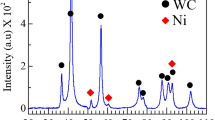Abstract
Although there are many primary carbides in the cutting edge of knives made of high-carbon martensitic steel, the effect of primary carbides on the sharpness of knives has not been clarified. In this paper, the evolution of primary carbides during the production process of 8Cr13MoV steel was presented. The effect of size and amount of primary carbides on the sharpness of knives was studied via employing rolling forging and diffusion annealing process, respectively. Results indicated that primary carbides easily fell off from cutting edge during cutting process, which would decrease the wear resistance of knives. The refinement of primary carbides could not only improve the wear resistance of cutting edge, but also weaken the fluctuation of sharpness during the service process of knives. By decreasing the amount of primary carbides, the wear resistance of knives would increase effectively, which improved the cutting performance effectively. Reducing the amount of primary carbides and refining the primary carbides in cutting edge were both effective ways to improve the sharpness of knives.

















Similar content being viewed by others
References
J.G. Thacker, G.T. Rodeheaver, M.A. Towler, and R.F. Edlich, Surgical Needle Sharpness, Am. J. Surg., 1989, 157(3), p 334–339
R.W. McGorry, P.C. Dowd, and P.G. Dempsey, Cutting Moments and Grip Forces in Meat Cutting Operations and the Effect of Knife Sharpness, Appl. Ergon., 2003, 34(4), p 375–382
S. Schuldt, G. Arnold, J. Kowalewski, Y. Schneider, and H. Rohm, Analysis of the Sharpness of Blades for Food Cutting, J. Food Eng., 2016, 188, p 13–20
J. Marsot, L. Claudon, and M. Jacqmin, Assessment of Knife Sharpness by Means of a Cutting Force Measuring System, Appl. Ergon., 2007, 38, p 83–89
S. Adriana, C.G. Aude, W. Pascal, R. Gilles, A.C. Agnes, and C. Laurent, Objective Assessment of Knife Sharpness Over a Working Day Cutting Meat, Appl. Ergon., 2018, 68, p 109–116
B. Bergmann and T. Grove, Basic Principles for the Design of Cutting Edge Roundings, CIRP Ann. Manuf. Techn., 2018, 67(1), p 73–78
J. Karltun, K. Vogel, M. Bergstrand, and J. Eklund, Maintaining Knife Sharpness in Industrial Meat Cutting: A Matter of Knife or Meat Cutter Ability, Appl. Ergon., 2016, 56, p 92–100
D.V. John, H.P. Alfred, and F.C. Howard, Wear Tests of Steel Knife Blades, Wear, 2008, 265, p 1093–1099
W.T. Yu, J. Li, C.B. Shi, and Q.T. Zhu, Effect of Electroslag Remelting Parameters on Primary Carbides in Stainless Steel 8Cr13MoV, Mater. Trans., 2016, 57(9), p 1547–1551
Q.T. Zhu, J. Li, C.B. Shi, and W.T. Yu, Effect of Quenching Process on the Microstructure and Hardness of High-Carbon Martensitic Stainless Steel, J. Mater. Eng. Perform., 2015, 24(11), p 4313–4321
Q.T. Zhu, J. Li, C.B. Shi, W.T. Yu, C.M. Shi, and J.H. Li, Precipitation Behavior of Carbides in High-Carbon Martensitic Stainless Steel, Int. J. Mater. Res., 2017, 108(1), p 20–28
Q.T. Zhu, J. Li, C.B. Shi, and W.T. Yu, Effect of Electroslag Remelting on Carbides in 8Cr13MoV Martensitic Stainless Steel, Int. J. Min. Met. Mater., 2015, 22(11), p 1149–1156
L. Xu, J. Xing, S. Wei, Y. Zhang, and R. Long, Study on Relative Wear Resistance and Wear Stability of High-Speed Steel with High Vanadium Content, Wear, 2007, 262(3-4), p 253–261
E. Badisch and C. Mitterer, Abrasive Wear of High Speed Steels: Influence of Abrasive Particles and Primary Carbides on Wear Resistance, Tribol. Int., 2003, 36(10), p 765–770
H.T. Phan, A.K. Tieu, H. Zhu, B. Kosasih, Q. Zhu, A. Grima, and T.D. Ta, A Study of Abrasive Wear on High Speed Steel Surface in Hot Rolling by Discrete Element Method, Tribol. Int., 2017, 110, p 66–76
W.T. Yu, J. Li, C.B. Shi, and Q.T. Zhu, Effect of Titanium on the Microstructure and Mechanical Properties of High-Carbon Martensitic Stainless Steel 8Cr13MoV, Metals, 2016, 6(8), p 1–15
J. Li, X. Yan, and X. Liang, Influence of Different Cryogenic Treatments on High-Temperature Wear Behavior of M2 Steel, Wear, 2017, 376-377, p 1112–1121
W.X. Song, Metallography, Metallurgical Industry Press, Beijing, 2011, p 326
Acknowledgment
This work was financially supported by the National Natural Science Foundation of China (Grant Nos. 51574025 and 51504019) and the Sail Plan of Guangdong Province to Introduce Innovation and Entrepreneurship Team (Grant No. 2016YT03C071).
Author information
Authors and Affiliations
Corresponding author
Additional information
Publisher's Note
Springer Nature remains neutral with regard to jurisdictional claims in published maps and institutional affiliations.
Rights and permissions
About this article
Cite this article
Zhu, Qt., Li, J., Zhang, J. et al. Effect of Primary Carbides on the Sharpness of Kitchen Knives Made of 8Cr13MoV Steel. J. of Materi Eng and Perform 28, 4511–4521 (2019). https://doi.org/10.1007/s11665-019-04209-6
Received:
Revised:
Published:
Issue Date:
DOI: https://doi.org/10.1007/s11665-019-04209-6




